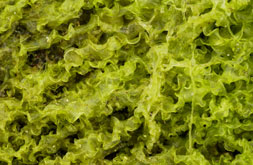The Seaweed Site: information on marine and other algae
This site is a free source of general information on all aspects of seaweeds. Seaweeds are marine algae: saltwater-dwelling, simple organisms that fall into the somewhat outmoded, but still generally useful category of "plants". Most of them are the green (more than 1800 species), brown (about 2000 species) or red (over 7200 species) kinds, samples of which are each illustrated on this page, and most are attached by holdfasts, which generally just have an anchorage function, although a particularly efficient one.
Here are some guides that you will find useful:
Do you know any seaweeds?
Most people know two general categories of seaweeds: wracks (species of the brown algal order Fucales such as Fucus) and kelps (species of the brown algal order Laminariales such as Laminaria), and many of you have heard of Carrageen or Irish Moss (usually the red alga, Chondrus crispus) and Dulse or Dillisk (also a red alga, Palmaria palmata). Seaweeds also make up the Sargasso Sea, a large ocean gyre in the western Atlantic where drift plants of several species of the genus Sargassum accumulate, and which has become much more extensive in recent years resulting in problem casts on many coasts of North America and the Caribbean. Seaweeds are particularly important ecologically: they dominate the rocky intertidal in most oceans, and in temperate and polar regions they cover rock surfaces in the shallow subtidal. Although only penetrating to depths of 8-40 m in most oceans, seaweeds can be found to depths of 250 m in particularly clear waters (some parts of the Mediterranean, Caribbean, Brazil). The Giant Kelp (species of Macrocystis) is one of the largest plants in the world, and in western North America where it forms an important association with the Sea Otter.
Yummy Seaweed?
Seaweeds are found throughout the world's oceans and seas and none is known to be poisonous. Many are actually nice to eat and some are even considered to be great delicacies in many Asian countries. Some recent, healthy recipes can be found here. Seaweeds are used in many maritime regions for industrial applications, and as a fertiliser. The major direct use of these plants as food is in Japan, China, and Korea, and in the Indian Ocean where seaweed cultivation has become a major coastal industry. The main food species grown by aquaculture in these countries are Nori or Zicai (Porphyra or Pyropia, red algae), Kombu, Kunbu or Haidai (Laminaria or Saccharina: brown algae) and Wakame ( Undaria, also a brown alga). In Japan alone, the total annual production value of nori amounts to more than US$2 billion, one of the most valuable crops produced by aquaculture in the world. In most western countries, seaweed consumption is relatively restricted and there has not been any great pressure to develop mass cultivation techniques. On this site, seaweed aquaculture, particularly of nori, a Japanese red seaweed used as a sushi wrap (see child's excitment) , is described in detail.
Uses of Seaweed
Industrial utilisation of seaweed is mostly centred on the extraction of phycocolloids (marine hydrocolloids), and, to a lesser extent, liquid seaweed extracts and some fine biochemicals. Fermentation and pyrolysis and the use of seaweed as biofuels and a source of biochemicals are not an option on an industrial scale at present, but are a potential option for the future, particularly as conventional fossil fuels run out. Seaweeds are being used in cosmetics, and as organic fertilisers. They have the potential to be much more widely used as a source of long- and short-chained biochemicals with medicinal and industrial uses. Marine algae may also be used as energy-collectors and potentially useful substances may be extracted by fermentation and pyrolysis. Seaweed extracts appear in the most unexpected of places; you almost certainly have eaten some sort of seaweed extract in the last 24 hours as many processed foods such as chocolate milk, yoghurts, health drinks, and even some beers and stouts may contain seaweed polysaccharides such as agars, carrageenans and alginates! Seaweed baths have been popular in Ireland and Britain since Edwardian times, and seaweed wraps and treatments have become very poular recently.
-
 BioAtlantis
provides sustainable technologies from the sea to enhance
plant, animal and human health.
BioAtlantis
provides sustainable technologies from the sea to enhance
plant, animal and human health.
-
 Connemara Organic Seaweed Company
provide hand harvested, sustainable, kelp and seaweed products
for human consumption through health supplements and edible
products.
Connemara Organic Seaweed Company
provide hand harvested, sustainable, kelp and seaweed products
for human consumption through health supplements and edible
products.
-
 Emerald Isle Organic Irish Seaweed.
A family business producing seaweed as supplements,
cooking, gardening and bath products.
Emerald Isle Organic Irish Seaweed.
A family business producing seaweed as supplements,
cooking, gardening and bath products.
-
 Irish Seaweeds Ltd
are suppliers of 100% natural hand-harvested seaweeds and
edible sea vegetable products from Ireland.
Irish Seaweeds Ltd
are suppliers of 100% natural hand-harvested seaweeds and
edible sea vegetable products from Ireland.


